Product Description
GIICL Type industries transportation Drum gear shaft coupling for motor
Description:
1. Strong load-bearing capacity. Under the same outer diameter of the inner gear sleeve and the maximum outer diameter of the coupling, the bearing capacity of the drum gear coupling is increased by an average of 15-20% compared to the straight gear coupling;
2. The angular displacement compensation is large. When the radial displacement is equal to zero, the allowable angular
displacement of the straight tooth coupling is 1o, while the allowable angular displacement of the drum tooth coupling is 1o30 ‘, an increase of 50%. Under the same modulus, number of teeth, and tooth width, the allowable angular displacement of drum shaped teeth is greater than that of straight teeth;
3. The drum shaped tooth surface improves the contact conditions between the inner and outer teeth, avoiding the drawbacks of extrusion and stress concentration at the edge of straight teeth under angular displacement conditions. At the same time, it improves the friction and wear conditions of the tooth surface, reduces noise, and has a long maintenance cycle;
4. The outer gear sleeve has a CHINAMFG shaped tooth end, making it very convenient to assemble and disassemble the inner and outer teeth;
5. Transmission efficiency up to 99.7%;
Based on the above characteristics, drum shaped teeth have been widely used domestically and internationally to replace straight tooth couplings.
Technical data:
Application:
Belt conveyers, csraper conveyers, and conveyers of all kinds Bucket elevators, ball mills, hoisters, crushers, excavators, mixers, straighteners, cranes, etc.
Packing & Delivery:
Tight packaging to protect the product from damage. Support a variety of payment and transportation methods.
FAQ:
Q 1: Are you a trading company or a manufacturer?
A: We are a professional manufacturer specializing in manufacturing
various series of couplings.
Q 2:Can you do OEM?
Yes, we can. We can do OEM & ODM for all the customers with customized artworks in PDF or AI format.
Q 3:How long is your delivery time?
Generally, it is 20-30 days if the goods are not in stock. It is according to quantity.
Q 4: How long is your warranty?
A: Our Warranty is 12 months under normal circumstances.
Q 5: Do you have inspection procedures for coupling?
A:100% self-inspection before packing.
Q 6: Can I have a visit to your factory before the order?
A: Sure, welcome to visit our factory.
/* January 22, 2571 19:08:37 */!function(){function s(e,r){var a,o={};try{e&&e.split(“,”).forEach(function(e,t){e&&(a=e.match(/(.*?):(.*)$/))&&1
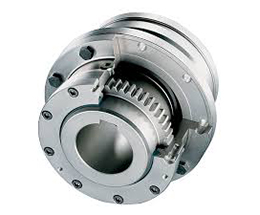
Common Industries and Use Cases for Flexible Gear Couplings
Flexible gear couplings find widespread applications across various industries due to their ability to transmit torque efficiently while accommodating misalignments and reducing vibrations. Some of the common industries and specific use cases include:
1. Power Generation:
Flexible gear couplings are extensively used in power generation plants, including thermal power plants, hydroelectric power plants, and wind farms. They connect turbines, generators, and other rotating equipment, allowing for smooth power transmission and accommodating misalignments caused by thermal expansion or settling.
2. Steel and Metal Processing:
In steel and metal processing industries, flexible gear couplings are employed in rolling mills, continuous casting machines, and other heavy machinery. They handle the high torque and misalignments that occur during metal forming processes, providing reliable power transmission and reducing downtime.
3. Petrochemical and Oil & Gas:
These industries often deal with harsh environments, high temperatures, and corrosive substances. Flexible gear couplings with appropriate materials and coatings are used in pumps, compressors, and other critical equipment to ensure efficient power transmission and reliability.
4. Mining:
Mining operations involve large machines and heavy loads, requiring couplings that can handle substantial torque and misalignment. Flexible gear couplings are used in conveyor systems, crushers, and other mining equipment to maintain smooth and efficient operation.
5. Marine and Shipbuilding:
In marine applications, flexible gear couplings are used to connect marine diesel engines to propeller shafts. They absorb vibrations and misalignments caused by the motion of the ship, ensuring reliable power transmission and reduced wear on the propulsion system.
6. Pulp and Paper:
In the pulp and paper industry, flexible gear couplings are utilized in various stages of the papermaking process, including pulp refiners, digesters, and winding machines. They provide precision torque transmission and minimize vibrations, contributing to the efficiency of the paper production process.
These are just a few examples, and flexible gear couplings can be found in many other industries, such as cement, chemical, food and beverage, and more. Their versatility and ability to handle challenging conditions make them a preferred choice in various power transmission applications across industries.
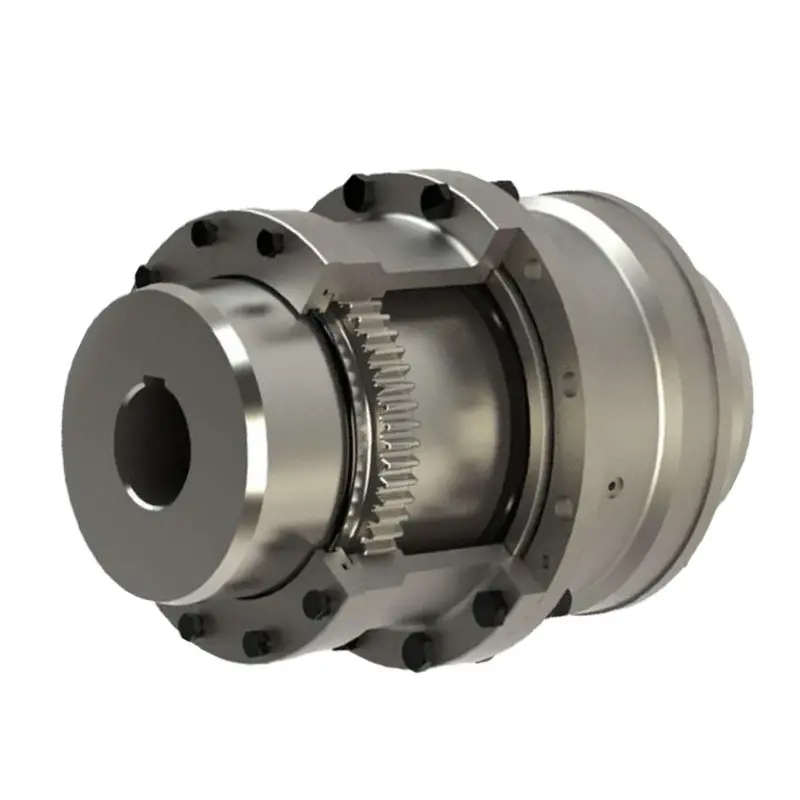
Potential Causes of Failure in Flexible Gear Couplings and Prevention
Flexible gear couplings, like any mechanical component, may experience failures if not properly maintained or operated. Some potential causes of failure and ways to prevent them include:
- Misalignment: Misalignment between the shafts can cause excessive stress on the coupling components, leading to failure. Regularly check and align the shafts to ensure they are properly aligned within specified tolerances.
- Overloading: Exceeding the rated torque capacity of the coupling can result in premature failure. Always operate within the recommended torque limits and avoid sudden shock loads.
- Poor Lubrication: Inadequate or improper lubrication can lead to increased friction, wear, and overheating. Follow the manufacturer’s guidelines for lubrication frequency and use the correct type of lubricant.
- Corrosion: Exposure to corrosive environments can degrade the coupling’s material over time. Select couplings made from corrosion-resistant materials or use protective coatings when necessary.
- Fatigue: Cyclic loading and continuous operation can cause fatigue failure in flexible gear couplings. Ensure the coupling is rated for the application’s required number of cycles and replace it if it shows signs of fatigue or wear.
- Temperature: Operating the coupling at temperatures beyond its limits can lead to material degradation and reduced performance. Check the coupling’s temperature rating and operate within the specified range.
Regular inspection, maintenance, and adherence to the manufacturer’s guidelines are essential to prevent failure and ensure the reliable performance of flexible gear couplings. Implementing preventive measures can extend the couplings’ lifespan, minimize downtime, and enhance the overall efficiency of the machinery they are part of.
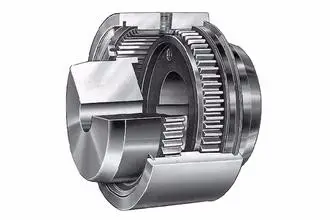
Different Types of Flexible Gear Couplings and Their Applications
Flexible gear couplings are available in various designs, each suited for specific applications based on their features and capabilities. Some common types of flexible gear couplings and their applications include:
- Full Gear Couplings: These couplings consist of two hubs with external gear teeth that mesh with an internal gear sleeve. They offer high torque capacity and are commonly used in heavy machinery, such as steel rolling mills, cranes, and conveyors.
- Half Gear Couplings: Half gear couplings have one flexible half with internal gear teeth and one rigid half with external gear teeth. They are ideal for applications requiring torsional rigidity and misalignment compensation, such as pumps and compressors.
- Nylon Sleeve Gear Couplings: These couplings have a nylon sleeve inserted between the gear teeth of the hubs and the internal sleeve. They are known for their vibration damping properties and are used in applications where noise reduction is essential, such as printing presses and textile machinery.
- Chain Gear Couplings: Chain gear couplings use chains to transmit torque between the hubs. They are well-suited for high-speed and high-torque applications and can accommodate significant misalignment. These couplings find applications in turbines, generators, and large fans.
- U-Joint Gear Couplings: These couplings have a universal joint-like mechanism that compensates for angular misalignment. They are commonly used in automotive drivetrains, agricultural equipment, and marine propulsion systems.
- Spacer Gear Couplings: Spacer gear couplings have two hubs separated by a spacer that accommodates large misalignments. They are commonly used in paper mills, mining equipment, and other heavy machinery.
When selecting a flexible gear coupling, it is essential to consider the specific requirements of the application, including torque, speed, misalignment, and environmental conditions, to choose the most suitable type for optimal performance and longevity.


editor by CX 2024-05-02
China Best Sales Transmission Couplings Steel Customized Shaft Hole Motor Spline Gicl Flexible Shaft Drum Gear Coupling
Product Description
Transmission Couplings Steel customized shaft hole Motor Spline GICL Flexible Shaft Drum Gear Coupling
Description:
The GICL drum gear coupling consists of a half coupling with the same number of teeth, an inner ring and an outer flange.The outer teeth are straight teeth and 2 kinds of drum teeth. The tooth is the outer sphere of the tooth.
(1)GIICL allows greater angular displacement (relative to straight tooth coupling), which can improve tooth contact conditions, improve transmission torque capacity and extend service life.The contact state of the angular displacement along the tooth width direction.
(2) compensation capability of radial, axial and angular deviation and axial deviation with compact structure, small turning radius, large bearing capacity, high transmission efficiency, low noise and long maintenance cycle;
(3) applicable to low-speed and high-load conditions, such as metallurgy, mining, lifting and transportation industries, as well as the driving shaft, general machinery and other machinery of the petrochemical industry.
Characteristics:
1.Widely used in various mechanical and hydraulic fields
2.Low-cost maintainance
3.Compensation for axial,radial and angular misalignment
4.Convenient axial plugging assembly
5. Installed horizontally and vertically without using any special tools.
6. Excellent mechanical properties
7. No brittlement at low temperature
8. Good sliding and frictional properties
9. Exellent electrical insulation
Parameters:
Packing & shipping:
1 Prevent from damage.
2. As customers’ requirements, in perfect condition.
3. Delivery : As per contract delivery on time
4. Shipping : As per client request. We can accept CIF, Door to Door etc. or client authorized agent we supply all the necessary assistant.
FAQ:
Q 1: Are you a trading company or a manufacturer?
A: We are a professional manufacturer specializing in manufacturing various series of couplings.
Q 2:Can you do OEM?
Yes, we can. We can do OEM & ODM for all the customers with customized artworks in PDF or AI format.
Q 3:How long is your delivery time?
Generally, it is 20-30 days if the goods are not in stock. It is according to quantity.
Q 4: How long is your warranty?
A: Our Warranty is 12 months under normal circumstances.
Q 5: Do you have inspection procedures for coupling?
A:100% self-inspection before packing.
Q 6: Can I have a visit to your factory before the order?
A: Sure, welcome to visit our factory.
/* January 22, 2571 19:08:37 */!function(){function s(e,r){var a,o={};try{e&&e.split(“,”).forEach(function(e,t){e&&(a=e.match(/(.*?):(.*)$/))&&1
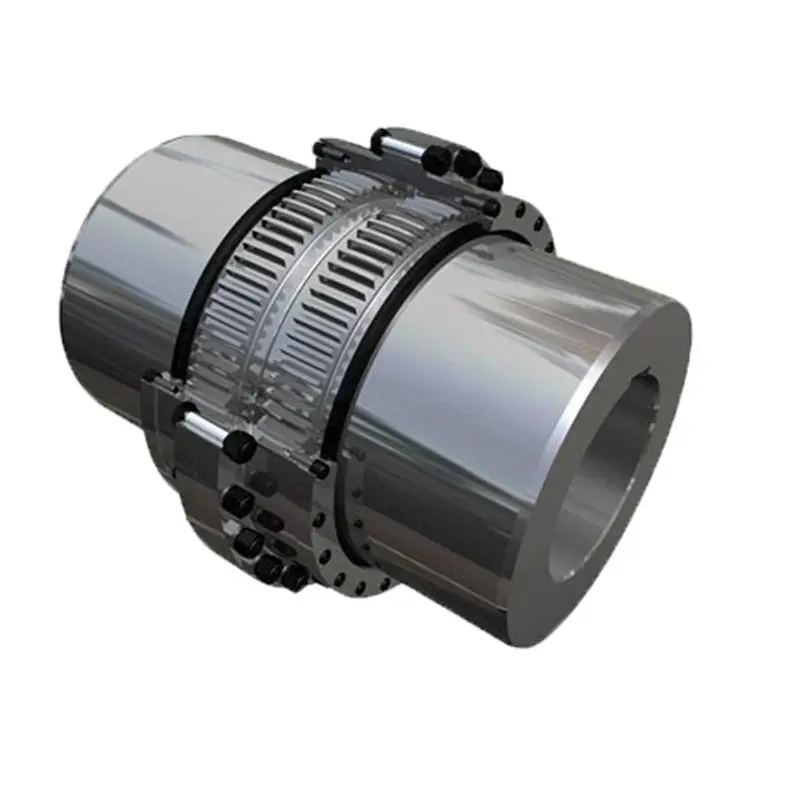
Maintenance Requirements for Flexible Gear Couplings
To extend the lifespan and ensure optimal performance of flexible gear couplings, regular maintenance is essential. Here are the key maintenance requirements:
- Lubrication: Proper lubrication is crucial for flexible gear couplings. Regularly inspect the coupling’s lubrication system and ensure it is filled with the recommended lubricant. Adequate lubrication reduces friction, wear, and heat generation, leading to smoother operation and increased lifespan.
- Inspection: Regularly inspect the flexible gear coupling for signs of wear, damage, or misalignment. Look for unusual vibrations, noise, or temperature increases during operation, as these may indicate issues that need attention.
- Torque Monitoring: Periodically check the torque levels to ensure they are within the coupling’s specified limits. Overloading the coupling can lead to premature wear and failure.
- Bolt Tightening: Check and tighten the coupling bolts as needed. Vibrations and continuous operation can cause bolts to loosen over time, affecting the coupling’s performance.
- Alignment: If misalignment is detected during inspection, address it promptly. Proper shaft alignment is crucial for the coupling’s longevity and smooth operation.
- Environmental Considerations: Be mindful of the operating environment. In harsh conditions, such as corrosive or high-temperature environments, additional protective measures may be necessary to safeguard the coupling’s integrity.
Following these maintenance practices will help prevent premature wear, reduce downtime, and extend the lifespan of flexible gear couplings, ensuring reliable and efficient power transmission in the long run.

Handling Torsional Stiffness and Dynamic Balancing in Flexible Gear Couplings
Flexible gear couplings are designed to effectively handle torsional stiffness and dynamic balancing in rotating machinery. Here’s how they achieve this:
- Torsional Stiffness: Flexible gear couplings are engineered to provide a certain level of torsional stiffness while still allowing for some flexibility. This stiffness helps transmit torque efficiently from one shaft to another, ensuring minimal power loss. The flexibility of the coupling allows it to accommodate misalignments and shock loads, reducing the risk of damage to connected equipment.
- Dynamic Balancing: Proper dynamic balancing is crucial in rotating machinery to prevent vibrations that could lead to premature wear and damage. Flexible gear couplings are designed to have symmetrical and evenly distributed masses. This helps minimize any dynamic imbalances that could occur during rotation, resulting in smoother and more stable operation.
The combination of torsional stiffness and dynamic balancing in flexible gear couplings makes them suitable for various industrial applications, providing reliable power transmission while dampening vibrations and accommodating misalignments. It ensures that the connected machinery operates efficiently and with reduced wear and tear, resulting in longer equipment lifespan and enhanced overall system performance.
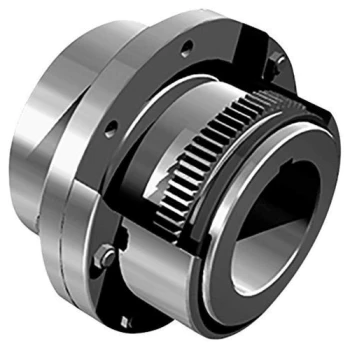
Advantages of Flexible Gear Couplings
Flexible gear couplings offer several advantages over other types of couplings:
- Misalignment Compensation: Flexible gear couplings can accommodate angular, parallel, and axial misalignments between the connected shafts. This ability to compensate for misalignment reduces stress on the machinery, shafts, and bearings, leading to improved overall system reliability and reduced maintenance requirements.
- Vibration Damping: The elastomeric flexible element in the coupling acts as a damping mechanism, absorbing vibrations and shocks during operation. This feature helps in reducing noise levels and protecting the connected equipment from damage caused by excessive vibrations.
- High Torque Transmission: Flexible gear couplings are designed to handle high torque loads, making them suitable for heavy-duty applications in various industries.
- Compact Design: Compared to some other types of couplings, flexible gear couplings have a relatively compact design, making them suitable for applications with space constraints.
- Easy Installation and Maintenance: The simple design and flexible nature of these couplings make them easy to install and maintain, minimizing downtime and associated costs.
- Reliability: Flexible gear couplings are known for their reliability and long service life, ensuring uninterrupted power transmission in critical industrial processes.
- Torsional Flexibility: The elastomeric material used in the coupling provides high torsional flexibility, enabling smooth torque transmission even in applications with varying loads and speeds.
Overall, the advantages of flexible gear couplings make them a popular choice for power transmission systems in various industries, including mining, steel, paper, and chemical processing, where the demands for performance, reliability, and durability are essential.


editor by CX 2024-04-22
China Standard Transmission Couplings Steel Customized Shaft Hole Motor Spline Gicl Flexible Shaft Drum Gear Coupling
Product Description
Transmission Couplings Steel customized shaft hole Motor Spline GICL Flexible Shaft Drum Gear Coupling
Description:
The GICL drum gear coupling consists of a half coupling with the same number of teeth, an inner ring and an outer flange.The outer teeth are straight teeth and 2 kinds of drum teeth. The tooth is the outer sphere of the tooth.
(1)GIICL allows greater angular displacement (relative to straight tooth coupling), which can improve tooth contact conditions, improve transmission torque capacity and extend service life.The contact state of the angular displacement along the tooth width direction.
(2) compensation capability of radial, axial and angular deviation and axial deviation with compact structure, small turning radius, large bearing capacity, high transmission efficiency, low noise and long maintenance cycle;
(3) applicable to low-speed and high-load conditions, such as metallurgy, mining, lifting and transportation industries, as well as the driving shaft, general machinery and other machinery of the petrochemical industry.
Characteristics:
1.Widely used in various mechanical and hydraulic fields
2.Low-cost maintainance
3.Compensation for axial,radial and angular misalignment
4.Convenient axial plugging assembly
5. Installed horizontally and vertically without using any special tools.
6. Excellent mechanical properties
7. No brittlement at low temperature
8. Good sliding and frictional properties
9. Exellent electrical insulation
Parameters:
Packing & shipping:
1 Prevent from damage.
2. As customers’ requirements, in perfect condition.
3. Delivery : As per contract delivery on time
4. Shipping : As per client request. We can accept CIF, Door to Door etc. or client authorized agent we supply all the necessary assistant.
FAQ:
Q 1: Are you a trading company or a manufacturer?
A: We are a professional manufacturer specializing in manufacturing various series of couplings.
Q 2:Can you do OEM?
Yes, we can. We can do OEM & ODM for all the customers with customized artworks in PDF or AI format.
Q 3:How long is your delivery time?
Generally, it is 20-30 days if the goods are not in stock. It is according to quantity.
Q 4: How long is your warranty?
A: Our Warranty is 12 months under normal circumstances.
Q 5: Do you have inspection procedures for coupling?
A:100% self-inspection before packing.
Q 6: Can I have a visit to your factory before the order?
A: Sure, welcome to visit our factory.
/* January 22, 2571 19:08:37 */!function(){function s(e,r){var a,o={};try{e&&e.split(“,”).forEach(function(e,t){e&&(a=e.match(/(.*?):(.*)$/))&&1

Maintenance Requirements for Flexible Gear Couplings
To extend the lifespan and ensure optimal performance of flexible gear couplings, regular maintenance is essential. Here are the key maintenance requirements:
- Lubrication: Proper lubrication is crucial for flexible gear couplings. Regularly inspect the coupling’s lubrication system and ensure it is filled with the recommended lubricant. Adequate lubrication reduces friction, wear, and heat generation, leading to smoother operation and increased lifespan.
- Inspection: Regularly inspect the flexible gear coupling for signs of wear, damage, or misalignment. Look for unusual vibrations, noise, or temperature increases during operation, as these may indicate issues that need attention.
- Torque Monitoring: Periodically check the torque levels to ensure they are within the coupling’s specified limits. Overloading the coupling can lead to premature wear and failure.
- Bolt Tightening: Check and tighten the coupling bolts as needed. Vibrations and continuous operation can cause bolts to loosen over time, affecting the coupling’s performance.
- Alignment: If misalignment is detected during inspection, address it promptly. Proper shaft alignment is crucial for the coupling’s longevity and smooth operation.
- Environmental Considerations: Be mindful of the operating environment. In harsh conditions, such as corrosive or high-temperature environments, additional protective measures may be necessary to safeguard the coupling’s integrity.
Following these maintenance practices will help prevent premature wear, reduce downtime, and extend the lifespan of flexible gear couplings, ensuring reliable and efficient power transmission in the long run.

Potential Causes of Failure in Flexible Gear Couplings and Prevention
Flexible gear couplings, like any mechanical component, may experience failures if not properly maintained or operated. Some potential causes of failure and ways to prevent them include:
- Misalignment: Misalignment between the shafts can cause excessive stress on the coupling components, leading to failure. Regularly check and align the shafts to ensure they are properly aligned within specified tolerances.
- Overloading: Exceeding the rated torque capacity of the coupling can result in premature failure. Always operate within the recommended torque limits and avoid sudden shock loads.
- Poor Lubrication: Inadequate or improper lubrication can lead to increased friction, wear, and overheating. Follow the manufacturer’s guidelines for lubrication frequency and use the correct type of lubricant.
- Corrosion: Exposure to corrosive environments can degrade the coupling’s material over time. Select couplings made from corrosion-resistant materials or use protective coatings when necessary.
- Fatigue: Cyclic loading and continuous operation can cause fatigue failure in flexible gear couplings. Ensure the coupling is rated for the application’s required number of cycles and replace it if it shows signs of fatigue or wear.
- Temperature: Operating the coupling at temperatures beyond its limits can lead to material degradation and reduced performance. Check the coupling’s temperature rating and operate within the specified range.
Regular inspection, maintenance, and adherence to the manufacturer’s guidelines are essential to prevent failure and ensure the reliable performance of flexible gear couplings. Implementing preventive measures can extend the couplings’ lifespan, minimize downtime, and enhance the overall efficiency of the machinery they are part of.

Industry Standards and Certifications for Flexible Gear Couplings
Flexible gear couplings are essential components in mechanical power transmission systems, and there are industry standards and certifications that govern their design, manufacturing, and performance. Some of the most commonly recognized standards and certifications for flexible gear couplings include:
- ISO 9001: This certification ensures that the manufacturer follows a quality management system that meets international standards, ensuring consistent and reliable production of flexible gear couplings.
- AGMA Standards: The American Gear Manufacturers Association (AGMA) has published various standards related to gear couplings, including AGMA 9002 for flexible couplings, which provides guidelines for design, selection, installation, and lubrication.
- API Standards: The American Petroleum Institute (API) has established standards for couplings used in the oil and gas industry. API 671 specifically covers the requirements for special-purpose couplings, including gear couplings, used in petroleum, chemical, and gas industry services.
- CE Marking: The CE marking indicates that the flexible gear coupling complies with the European Union’s health, safety, and environmental protection standards, making it eligible for sale within the EU market.
- ATEX Certification: If the flexible gear coupling is intended for use in potentially explosive atmospheres, it may require ATEX certification, which ensures compliance with European Union directives for explosive atmosphere protection.
When selecting a flexible gear coupling, it is essential to verify if it conforms to the necessary industry standards and certifications to ensure the coupling’s performance, safety, and reliability in your specific application.


editor by CX 2024-04-11
China Good quality Durable Hot Sale Flexible Electric Motor Shaft Coupling Giiclz Type Drum Gear Coupling
Product Description
Durable Hot Sale Flexible Electric Motor Shaft Coupling GIICLZ type drum Gear Coupling
Description:
Drum coupling is made up of external gear shaft sleeve with crowned teeth, carrying ring, end cup and sealing ring. It is mainly used for connecting cable drum and reducer output shaft of hoisting equipment. Operating temperature of this shaft coupling is -25 to 80ºC. Nominal torque is 16 to 560 KN.m and limited radial load is 18 to355 KN.
Features:
1. The production process of this drum coupling is stable and reliable. It is able to bear big radial direction load and also transfer big torque.
2. Shaft coupling has compact and firm structure. It adopts series design thus helps to simplify machine structure and reduce weight of equipment.
3. It is equipped with positioning wear indicator thus it is safe and reliable.
4. Drum coupling has good aligning performance. It is convenient for installation, adjustment and maintenance.
Parameters:
Application:
Drum coupling is suitable for machines that both transmit torque and bear radial load.
Packing & shipping:
1 Prevent from damage.
2. As customers’ requirements, in perfect condition.
3. Delivery : As per contract delivery on time
4. Shipping : As per client request. We can accept CIF, Door to Door etc. or client authorized agent we supply all the necessary assistant.
FAQ:
Q 1: Are you a trading company or a manufacturer?
A: We are a professional manufacturer specializing in manufacturing various series of couplings.
Q 2:Can you do OEM?
Yes, we can. We can do OEM & ODM for all the customers with customized artworks in PDF or AI format.
Q 3:How long is your delivery time?
Generally, it is 20-30 days if the goods are not in stock. It is according to quantity.
Q 4: How long is your warranty?
A: Our Warranty is 12 months under normal circumstances.
Q 5: Do you have inspection procedures for coupling?
A:100% self-inspection before packing.
Q 6: Can I have a visit to your factory before the order?
A: Sure, welcome to visit our factory. /* January 22, 2571 19:08:37 */!function(){function s(e,r){var a,o={};try{e&&e.split(“,”).forEach(function(e,t){e&&(a=e.match(/(.*?):(.*)$/))&&1
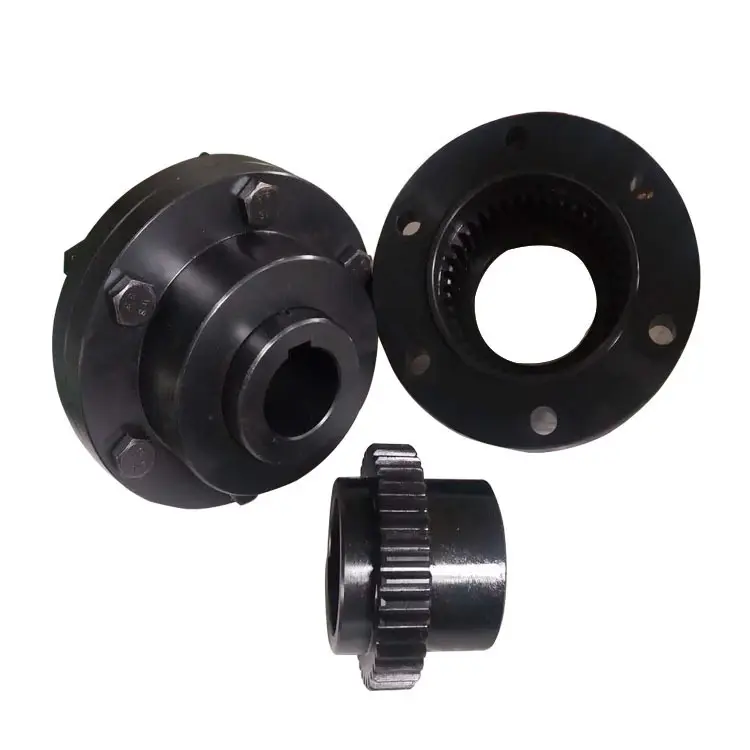
Flexibility of Flexible Gear Couplings in High-Temperature or Corrosive Environments
Flexible gear couplings are designed to operate in a wide range of environments, including high-temperature and corrosive conditions. Their construction and choice of materials allow them to withstand challenging industrial settings. Here’s how flexible gear couplings handle such conditions:
High-Temperature Environments:
Flexible gear couplings are often manufactured using heat-resistant materials, such as alloy steel or stainless steel. These materials can withstand elevated temperatures commonly found in various industrial processes. The design of the coupling allows for efficient heat dissipation, preventing the buildup of excess heat and ensuring reliable operation.
It is crucial to choose the appropriate material and lubrication for the specific high-temperature application to avoid premature wear and failure. Regular maintenance and monitoring are also essential to detect any signs of heat-related stress and take appropriate action promptly.
Corrosive Environments:
Flexible gear couplings can also be equipped with corrosion-resistant materials, such as stainless steel or nickel alloys, to withstand corrosive environments. These materials offer excellent resistance to chemical reactions and protect the coupling from degradation caused by exposure to aggressive substances.
The sealing mechanisms in some flexible gear couplings provide an additional layer of protection, preventing corrosive agents from entering the critical components of the coupling. Proper lubrication and maintenance are essential in corrosive environments to ensure the coupling’s longevity and reliable performance.
However, it is crucial to choose a flexible gear coupling with the appropriate materials and coatings that suit the specific corrosive environment in which it will operate. Working with reputable manufacturers or suppliers with experience in providing couplings for similar conditions is essential to ensure the coupling’s reliability and long-term performance in challenging environments.
In summary, flexible gear couplings can be successfully used in high-temperature and corrosive environments due to their robust construction, choice of materials, and efficient heat dissipation mechanisms. Proper selection, installation, and maintenance are key factors in maximizing the performance and lifespan of the coupling in such conditions.

Potential Causes of Failure in Flexible Gear Couplings and Prevention
Flexible gear couplings, like any mechanical component, may experience failures if not properly maintained or operated. Some potential causes of failure and ways to prevent them include:
- Misalignment: Misalignment between the shafts can cause excessive stress on the coupling components, leading to failure. Regularly check and align the shafts to ensure they are properly aligned within specified tolerances.
- Overloading: Exceeding the rated torque capacity of the coupling can result in premature failure. Always operate within the recommended torque limits and avoid sudden shock loads.
- Poor Lubrication: Inadequate or improper lubrication can lead to increased friction, wear, and overheating. Follow the manufacturer’s guidelines for lubrication frequency and use the correct type of lubricant.
- Corrosion: Exposure to corrosive environments can degrade the coupling’s material over time. Select couplings made from corrosion-resistant materials or use protective coatings when necessary.
- Fatigue: Cyclic loading and continuous operation can cause fatigue failure in flexible gear couplings. Ensure the coupling is rated for the application’s required number of cycles and replace it if it shows signs of fatigue or wear.
- Temperature: Operating the coupling at temperatures beyond its limits can lead to material degradation and reduced performance. Check the coupling’s temperature rating and operate within the specified range.
Regular inspection, maintenance, and adherence to the manufacturer’s guidelines are essential to prevent failure and ensure the reliable performance of flexible gear couplings. Implementing preventive measures can extend the couplings’ lifespan, minimize downtime, and enhance the overall efficiency of the machinery they are part of.
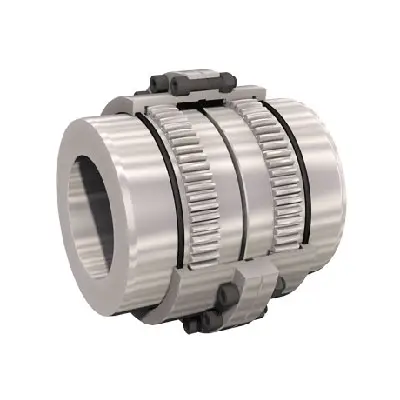
Accommodating Misalignment and Reducing Vibrations in Flexible Gear Couplings
Flexible gear couplings use an elastomeric flexible element, often made of high-quality rubber, to connect the two gear hubs. This design allows the coupling to accommodate misalignment between the connected shafts and reduce vibrations during operation.
1. Misalignment Accommodation: The flexible nature of the elastomeric element allows it to bend and flex as the shafts move out of alignment. Flexible gear couplings can accommodate three main types of misalignment:
- Angular Misalignment: Occurs when the shafts are not parallel and are at an angle to each other.
- Parallel Misalignment: Occurs when the shafts are not in a straight line but are parallel to each other.
- Axial Misalignment: Occurs when the shafts are displaced along their axis.
The ability to handle these types of misalignment is crucial in various industrial applications where machinery may experience movement, thermal expansion, or other dynamic forces.
2. Vibration Reduction: The elastomeric material in the flexible gear coupling acts as a damping mechanism. It absorbs and dissipates vibrations and shocks generated during operation. This damping effect helps in reducing noise levels and protects the connected equipment from damage caused by excessive vibrations.
Overall, the combination of misalignment accommodation and vibration reduction in flexible gear couplings contributes to improved system reliability, reduced maintenance requirements, and extended machinery life.


editor by CX 2024-04-09
China best Standard Gcld Type Curved Tooth Spline Motor Shaft Planetary Drum Rigid Gear Coupling gear coupling
Product Description
GCLD gear coupling Drum toothed coupling
Description:
GCLD series of drum gear coupling, especially suitable for low speed and heavy load conditions, such as metallurgy, mining, lifting and transportation industries, also suitable for petroleum, chemical, general machinery and other machinery shafting transmission.Characteristics of drum gear coupling (compared with straight gear coupling, it has the following characteristics).
Advantages:
1. The bearing capacity is strong.
2. Large amount of angular displacement compensation
3. The drum shaped tooth surface improves the contact conditions of the inner and outer teeth, avoids the disadvantages of edge extrusion and stress concentration at the straight tooth end under the condition of angular displacement, improves the friction and wear condition of the tooth surface, reduces the noise, and has a long maintenance cycle;
4. The tooth end of the outer tooth sleeve is in the shape of a horn, which makes the assembly and disassembly of the inner and outer teeth very convenient.
5. The transmission efficiency is as high as 99.7%.
Parameters:
Norminal Torque: 0.4kN. M – 4500kN. M
Allowed Rotation Speed: 4000rpm -460rpm
Connection: Keyway & Shaft hole
Shaft Hole Diameter: 16mm – 1040mm
Shaft Hole Length (Y): 42mm – 1100mm
Applications:
Metallurgy, mining, lifting and transportation industries, petroleum, chemical, general machinery and other heavy machinery shaft drive.
Packing & shipping:
1 Prevent from damage.
2. As customers’ requirements, in perfect condition.
3. Delivery : As per contract delivery on time
4. Shipping : As per client request. We can accept CIF, Door to Door etc. or client authorized agent we supply all the necessary assistant.
FAQ:
Q 1: Are you a trading company or a manufacturer?
A: We are a professional manufacturer specializing in manufacturing various series of couplings.
Q 2:Can you do OEM?
Yes, we can. We can do OEM & ODM for all the customers with customized artworks in PDF or AI format.
Q 3:How long is your delivery time?
Generally, it is 20-30 days if the goods are not in stock. It is according to quantity.
Q 4: How long is your warranty?
A: Our Warranty is 12 months under normal circumstances.
Q 5: Do you have inspection procedures for coupling?
A:100% self-inspection before packing.
Q 6: Can I have a visit to your factory before the order?
A: Sure, welcome to visit our factory.
/* January 22, 2571 19:08:37 */!function(){function s(e,r){var a,o={};try{e&&e.split(“,”).forEach(function(e,t){e&&(a=e.match(/(.*?):(.*)$/))&&1

How Does a Gear Coupling Protect Connected Equipment from Shock Loads and Vibrations?
Gear couplings are designed to provide excellent protection to connected equipment from shock loads and vibrations, making them ideal for use in demanding and heavy-duty applications. The design and features of gear couplings that contribute to this protection include:
- Flexible and Rigid Elements: Gear couplings consist of two hubs with external gears that mesh together. Between these two hubs, there is a center sleeve with internal gear teeth. The center sleeve acts as a flexible element, while the outer hubs act as rigid elements. This combination allows the gear coupling to transmit torque while absorbing and dampening shock loads and vibrations.
- Misalignment Compensation: Gear couplings can accommodate angular, parallel, and axial misalignment between shafts. When the connected equipment experiences misalignment due to dynamic forces or shock loads, the gear coupling can flex and adjust to these changes, preventing excessive stress on the shafts and equipment.
- High Torsional Stiffness: Gear couplings offer high torsional stiffness, meaning they have minimal angular deflection under load. This stiffness helps maintain precise alignment and reduces the likelihood of damage to the connected equipment caused by misalignment-induced vibrations.
- Load Distribution: The toothed gear design of gear couplings ensures a large surface area of contact between the gears. This spreads the torque evenly across the gear teeth, resulting in a uniform distribution of load and reducing the concentration of stress on specific areas.
- Damping Characteristics: The flexible center sleeve in the gear coupling acts as a damping element that absorbs and dissipates vibrations, further protecting the connected equipment from harmful oscillations.
- High-Speed Balancing: Gear couplings are precisely balanced during manufacturing to minimize vibrations and ensure smooth operation even at high speeds. Proper balancing helps prevent resonances and reduces the impact of shock loads on the connected equipment.
By effectively absorbing and dampening shock loads and vibrations, gear couplings extend the life of the connected equipment and surrounding components, reduce maintenance requirements, and contribute to a more reliable and efficient mechanical system. However, it is essential to select the appropriate size and type of gear coupling based on the specific application and operating conditions to ensure optimal protection and performance.


editor by CX 2024-03-05
China supplier Giicl Type Industries Transportation Flexible Coupling Drum Gear Shaft Coupling for Motor gear coupling
Product Description
GIICL Type industries transportation Drum gear shaft coupling for motor
Description:
1. Strong load-bearing capacity. Under the same outer diameter of the inner gear sleeve and the maximum outer diameter of the coupling, the bearing capacity of the drum gear coupling is increased by an average of 15-20% compared to the straight gear coupling;
2. The angular displacement compensation is large. When the radial displacement is equal to zero, the allowable angular
displacement of the straight tooth coupling is 1o, while the allowable angular displacement of the drum tooth coupling is 1o30 ‘, an increase of 50%. Under the same modulus, number of teeth, and tooth width, the allowable angular displacement of drum shaped teeth is greater than that of straight teeth;
3. The drum shaped tooth surface improves the contact conditions between the inner and outer teeth, avoiding the drawbacks of extrusion and stress concentration at the edge of straight teeth under angular displacement conditions. At the same time, it improves the friction and wear conditions of the tooth surface, reduces noise, and has a long maintenance cycle;
4. The outer gear sleeve has a CHINAMFG shaped tooth end, making it very convenient to assemble and disassemble the inner and outer teeth;
5. Transmission efficiency up to 99.7%;
Based on the above characteristics, drum shaped teeth have been widely used domestically and internationally to replace straight tooth couplings.
Technical data:
Application:
Belt conveyers, csraper conveyers, and conveyers of all kinds Bucket elevators, ball mills, hoisters, crushers, excavators, mixers, straighteners, cranes, etc.
Packing & Delivery:
Tight packaging to protect the product from damage. Support a variety of payment and transportation methods.
FAQ:
Q 1: Are you a trading company or a manufacturer?
A: We are a professional manufacturer specializing in manufacturing
various series of couplings.
Q 2:Can you do OEM?
Yes, we can. We can do OEM & ODM for all the customers with customized artworks in PDF or AI format.
Q 3:How long is your delivery time?
Generally, it is 20-30 days if the goods are not in stock. It is according to quantity.
Q 4: How long is your warranty?
A: Our Warranty is 12 months under normal circumstances.
Q 5: Do you have inspection procedures for coupling?
A:100% self-inspection before packing.
Q 6: Can I have a visit to your factory before the order?
A: Sure, welcome to visit our factory.
/* January 22, 2571 19:08:37 */!function(){function s(e,r){var a,o={};try{e&&e.split(“,”).forEach(function(e,t){e&&(a=e.match(/(.*?):(.*)$/))&&1

Materials Used in Manufacturing Gear Couplings
Gear couplings are designed to transmit torque between shafts while accommodating misalignment. To ensure the durability and reliability of gear couplings, manufacturers use a variety of materials, each with its specific properties. Commonly used materials in manufacturing gear couplings include:
- Steel: Steel is the most widely used material for gear couplings. It offers excellent strength, durability, and resistance to wear and fatigue. Steel gear couplings are suitable for a wide range of applications, including heavy-duty industrial machinery.
- Stainless Steel: Stainless steel is chosen for gear couplings that require resistance to corrosion and high-temperature environments. Stainless steel couplings are commonly used in food processing, pharmaceutical, and chemical industries.
- Alloy Steel: Alloy steel is utilized to enhance specific properties, such as increased strength and improved performance under high loads and extreme conditions. Alloy steel gear couplings are ideal for demanding applications in heavy industries.
- Cast Iron: Cast iron is known for its excellent machinability and good resistance to wear. Cast iron gear couplings are suitable for low to moderate torque applications and can be cost-effective in certain scenarios.
- Non-Metallic Materials: In some cases, non-metallic materials like nylon or urethane may be used for specific gear coupling applications, especially in situations where electrical isolation or chemical resistance is required.
The choice of material depends on the application’s demands, including the torque, speed, environmental conditions, and budget considerations. Gear coupling manufacturers carefully select materials that will provide optimal performance and longevity while meeting the specific requirements of the intended application.


editor by CX 2024-03-01